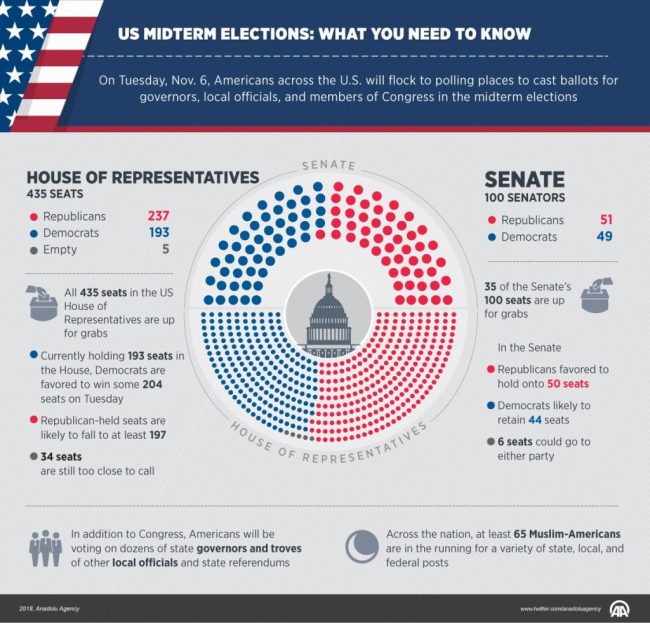Millions of Americans will head to the polls to cast their votes in the country’s midterm elections on Nov. 6.

While midterm elections have no bearing on who the head of state is, they could have a significant impact on President Donald Trump‘s ability to impose his mandate and the Democratic Party’s hopes of scuttling his policy agenda and pushing through its own measures.
What are the midterm elections?
As the name suggests, midterm elections are held in the middle of the presidential term.
Up for grabs in the 2018 elections are 435 seats in the House of Representatives, 35 seats in the Senate and 36 governors’ positions; there are also legislative races in 46 states and six territories.

The midterm elections allow American voters to re-assess the state of power, and elect representatives who can check the president’s agenda.
“You’re going to have different assessments of public opinion in a president’s term,” said University of Toronto political science professor Ryan Hurl. “It’s much more difficult for a president to maintain an agenda if that agenda – in practice – is not supported by a majority of the populations.”
WATCH: President Trump, former president Obama make campaign stumps ahead of midterms

House of Representatives
All 435 seats in the House of Representatives, which forms the lower chamber of the U.S. Congress, are up for grabs every midterm election cycle, with representatives serving two-year terms.
The seats are drawn from congressional districts drawn up in each of the 50 states based on their populations. California currently has the most seats at 53; the lower-populated states of Montana, Wyoming, Vermont, North Dakota and South Dakota only hold one seat each.
A total of 218 seats are required for a party to wrest control of the House. The Republican Party currently has 235 seats, and so enjoys a majority.
WATCH: A divided America heads to the polls
The Democrats have to net 23 seats to take the House — recent analyses from political forecasting groups suggest they’re in a good position to achieve that.
The odds of a Democratic victory have increased in 48 of the 65 races seen as competitive or leaning in favour of the Democrats, according to at least one of the three political forecasting groups: Cook Political Report, Inside Elections and the University of Virginia’s Center for Politics, according to a Reuters analysis.
Democrats have an 86.4 per cent chance of winning control of the House, according to a forecast by FiveThirtyEight.
Senate
While all seats of the House of Representatives go up for grabs each midterm cycle, only around one-third of Senate seats will be voted on — that’s because senators serve six-year terms.
Comprising the upper chamber of Congress, the Senate comprises 100 seats, meaning that a total of 51 seats are needed for a party to take control. The Republicans, with 51 senators, currently control the Senate.
Winning the Senate is poised to be a more difficult task for the Democrats, who are defending 26 of the 35 seats being contested.
That means there’s little margin for error if the Democrats want to take the Senate — they’d likely need to retain all 26 seats that they currently hold, as well as defeat a couple of Republicans.
To make things even more complicated for the Democrats, 10 of the seats they currently hold are in states that Trump carried in the 2016 presidential election.
WATCH: Trump says he’s confident about upcoming U.S. midterms

Few states exemplify the challenge facing the Democrats better than West Virginia, a state that elected a Democratic senator in Joe Manchin but also delivered Trump his most resounding victory in 2016, with 68 per cent of the vote.
As of last month, Trump enjoyed a 62 per cent approval rating in West Virginia, the highest of any state, according to Morning Consult.
Two other key Democrat-held states, Missouri and Indiana, are also at serious risk of flipping red, according to Sabato’s Crystal Ball, a nonpartisan election analysis project based in the Center for Politics at the University of Virginia.
READ MORE: On the eve of the midterms, America’s heartland is as divided as ever
“At this point, Republicans are in a better position than Democrats to go into the next Congress holding more seats than they hold now (51), and Democrats’ chances to win the overall majority are tiny,” wrote Kyle Kondik, managing editor of Sabato’s Crystal Ball.
FiveThirtyEight forecasts that the Republican Party has an 85.2 per cent chance of maintaining and possibly consolidating control of the Senate.
Governors’ races
If Democrats have little margin for error in Senate races, the same applies to Republicans in the gubernatorial races — the GOP is defending 26 states to the Democrats’ nine.
Among the most-watched races is Florida, where African-American Democratic candidate and Tallahassee Mayor Andrew Gillum is running against Trump-backed Republican Ron DeSantis, who served in the House of Representatives until last month.
The governorships matter to political parties because they could affect the way elections for the House of Representatives pan out for years to come.
In 2022, congressional districts will be redrawn based on the results of the 2020 census, explained Denise Barber, managing director of the National Institute on Money in Politics, on WNYC Studios’ “The Takeaway” podcast.
In most states, the party in power can redraw congressional and legislative districts to its advantage, a tactic known as gerrymandering.
Both parties play the gerrymandering game but the Republicans have done a better job of it in recent times, according to the Washington Post,
What’s the likely outcome?
For the two major political parties, the holy grail of midterm elections is to win a majority in both the House and the Senate, thereby seizing total legislative control.
However, most analysts and forecasters agree that the most likely scenario is that the Republicans keep control of the Senate, while the Democrats take the House.
Historically, the party of the sitting president has nearly always lost seats in the House. The Cook Political Report points out that this has occurred in 35 of the 38 midterm elections held since the U.S. Civil War ended in 1865.
Barack Obama’s Democrats lost 63 House seats during the first midterm in 2010, while the Republicans lost 30 seats during George W. Bush’s second term in 2006.
READ MORE: Trump begins rally blitz attacking media, stoking immigration fears
However, President Trump suggested that he’s not concerned by the burden of historical patterns.
“I feel very good about the Senate,” Trump told ABC News in an interview before a Wednesday rally in Estero, Fla. “And frankly I think we feel pretty good about the House.”
Barry Burden, professor of political science at the University of Wisconsin, characterized the rival political parties as “a Democratic Party that’s enthused and active” and a Republican Party “who are playing defense and hoping to hold on to what they have.”
What’s at stake?
Losing the House would represent a setback for the Republicans, as they would no longer be able to pass bills with Republican votes alone. That means much of Trump’s legislative agenda would largely be dead on arrival — meaning no border wall, no cuts to welfare and social security, and no further tax cuts.
It could also lead to a re-examination of immigration reform, which could mean revisiting the Obama-era Deferred Action for Childhood Arrivals (DACA) policy that shielded young people who came to the U.S. illegally with their parents from deportation.
WATCH: Major issues facing voters ahead of U.S. midterms

A Democrat takeover of the House would also leave Trump exposed to more aggressive investigations on issues such as Russian collusion and election meddling.
“They are going to be able to set up select committees on the investigation into the Trump administration,” said Geoffrey Skelley, a political analyst at the University of Virginia Centre For Politics.
The importance of the midterm elections has not been lost on President Trump. He’s in the midst of a blitz of rallies, and will have held 30 rallies between Labor Day on Sept. 3 and Election Day on Nov. 6, according to the White House.
WATCH: Trump insider talks midterm strategy on The West Block

Rally locations aren’t drawn out of a hat. Most of Trump’s events are being held in battleground House districts and in states with competitive Senate and gubernatorial races.
Speaking at a rally in Mosinee, Wis. on Oct. 24, Trump told crowds, “If you vote Republican this November, we will continue to cut your taxes, cut your regulations and raise your income.”
READ MORE: Trump supporters chant ‘Lock her up!’ at rally, hours after bomb mailed to Hillary Clinton
Just a couple hundred kilometres away, in Milwaukee, Obama dropped the gloves at a Democratic rally, delivering arguably his most stinging rebuke of Trump yet.
He accused Trump of blatantly “making stuff up,” and said that the president hadn’t made good on his promise to “drain the swamp.”
Obama plans to campaign for a number of Senate candidates, as Democrats look to pull off a shock Senate takeover.
WATCH: Obama slams Trump, Republicans at Wisconsin rally
Presidents and former presidents aside, regular Americans also appear to be more invested in the midterm elections than they have been in a long time.
Over 32 million ballots have already been cast in advance polls according to the U.S. Elections Project, which predicts that the 2018 midterms are on course to draw one of the highest turnout rates in midterm elections history.
Youth vote could be crucial
The 2018 midterms mark a demographic turning point: millennials will, for the first time, surpass baby boomers as the largest voting-eligible generation.
There were 8 million young people who weren’t old enough to vote when Trump was elected. Now, they can cast a ballot.
READ MORE: Elderly, rich, white Trump supporters taunt non-voting young people in satirical video
Young voters traditionally have a miserable track record when it comes to voting in midterm elections, but a slew of get-out-the-vote campaigns have pushed youth voter registration in some states to levels usually only seen during presidential campaigns.
WATCH: Surge in voter registration among young adults prompts push to get youth to vote in 2018 U.S. midterms

“I just turned 18 so I was super excited to be able to vote,” University of Wisconsin-Madison student Sophie Yarosh told Global News’ Washington bureau chief Jackson Proskow.
“Brett Kavanaugh and the Parkland shooting have shown us what’s at stake in this country,” said Nada Elmikashfi, chair of the university’s chapter of NextGen America, one of the organizations working to mobilize young and first-time voters.
“We’re the ones growing up in it, so that has motivated everyone to get out and vote.”
— With files from Jackson Proskow, Andrew Russell and the Associated Press







Comments